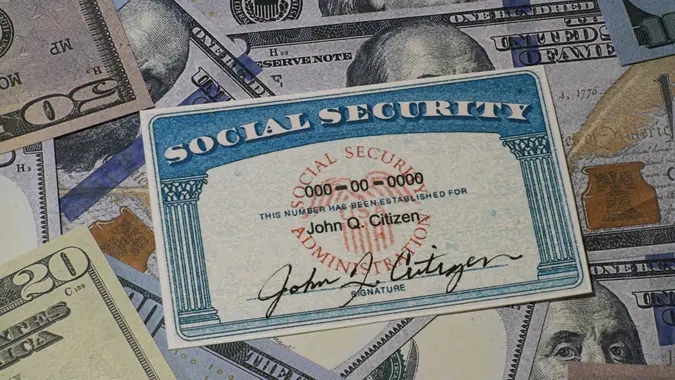I’m an Economist: Here’s My Prediction for Social Security If Kamala Harris Wins the Election

Commitment to Our Readers
GOBankingRates' editorial team is committed to bringing you unbiased reviews and information. We use data-driven methodologies to evaluate financial products and services - our reviews and ratings are not influenced by advertisers. You can read more about our editorial guidelines and our products and services review methodology.

20 Years
Helping You Live Richer

Reviewed
by Experts

Trusted by
Millions of Readers
For nearly a century, Social Security has been a staple for many American retirees. Today, around 67 million people rely on Social Security to help sustain them through retirement. However, there has been a lot of uncertainty about its future.
In a report from earlier this year, the Social Security and Medicare Trustees predicted that Social Security benefits will drop by as much as 21% in 2033 — just nine years away. Other systems, like Medicare, are also expected to be cut if no changes are made.
What this means is that younger Americans who are currently working and paying taxes could be paying into a system that won’t be there when they retire. And those who haven’t even started working yet are even less likely to receive any benefits at all.
All of this is assuming Social Security continues to run exactly as it has. But what if Kamala Harris is elected the next president? What might happen to this important system then?
GOBankingRates asked Dennis Shirshikov, a professor of finance, economics and accounting at City University of New York (CUNY). These are his predictions below, and you can also check out an expert’s predictions if Trump wins here.
There Could Be Significant Reforms on the Horizon
If Harris becomes the next president, Shirshikov predicts there will be some major changes.
“I anticipate that Social Security will undergo significant reforms aimed at enhancing its sustainability and expanding benefits,” he said. “Harris has shown support for measures to protect and strengthen Social Security, including proposals to increase benefits for low-income retirees and to adjust the cost-of-living adjustments (COLA) formula to better reflect the expenses faced by seniors.”
In regard to COLA, it’s possible that Harris will prioritize these adjustments to better reflect the actual cost of living seniors face. This may or may not account for inflation or rising healthcare costs. But even if it doesn’t, it could still result in larger benefits — provided the system can keep up.
Depending on how successful these reforms are, the Social Security system could theoretically become stronger and more secure. This could push it past the predicted 2033 date and ensure the percentage of scheduled benefits payable to recipients is the full amount — rather than a 21% cut.
There Could Be a New Rate Cap
Along with this, Shirshikov predicts that Harris could advocate for lifting the cap on taxable income for Social Security. Currently, there’s a 12.4% Social Security tax on employers and employees — split equally between the two — on those who earn up to $168,600.
If the rate cap is lifted or even removed altogether, it could lead to greater sustainability in the system — well past 2033. This is because a higher payroll tax cap would ensure high-income earners contribute more to the system, thus replenishing — or at least stabilizing — the available funds.
In addition to bringing in more revenue from those who can more readily afford it, removing the cap also could protect those with fewer financial means. It’s certainly not a guarantee, but it could certainly help fund the program.
Benefits Could Be Calculated Differently
“We could see changes in the way benefits are calculated to provide more substantial support for those with lower lifetime earnings,” Shirshikov said.
Right now, Social Security benefits are calculated using a very specific formula. To keep the system going past the next decade — with the full expected benefits amount for all those paying into the system — there may need to be changes to how benefits are calculated and doled out.
For example, certain groups of people may receive reduced benefits — something that’s already bound to happen if nothing changes. But if specific strategies are implemented, it could mean tactically lower benefits for wealthier retirees. This, in turn, could leave more money on the table for those who need it most.
To give further context, the estimated average monthly benefit amount is $1,907. An individual who earns $60,000 a year and retires right now at the age of 70 would receive a maximum benefit of around $2,289 a month (assuming no changes in earnings). If they earned $130,000 a year, they’d receive around $3,800 a month.
Even that’s a significant potential discrepancy in benefits amount, especially considering how lower-income earners may need a higher amount. Regardless, if benefits are cut by 21%, that’s a significant reduction in both examples — minus $798 a month for the higher earner and minus $481 for the lower earner.
Long-Term Solvency Could Be Addressed
Shirshikov also predicted that there could be initiatives to address the long-term solvency of the program as a whole. Two particular areas he suggested might change:
- Gradual adjustments to the current retirement age
- Diversification of how Social Security funds are invested
Currently, you can start receiving Social Security benefits as soon as you turn 62. This is considered “early retirement” and likely will result in a reduced benefits amount.
Alternatively, you can wait until the full retirement age (FRA), which is 66 to 67 years old for most eligible recipients (the exact age depends on the year of birth). For every year you wait to receive benefits beyond the FRA, you’ll receive an additional 8% to your benefit amount (up to a certain point). In any case, extending the current retirement age could be a long-term solution to the system.
As far as diversifying the way Social Security funds are currently invested, how and when this might change is yet to be determined.
Editor’s note on election coverage: GOBankingRates is nonpartisan and strives to cover all aspects of the economy objectively and present balanced reports on politically focused finance stories. For more coverage on this topic, please check out I’m an Economist: Here’s My Prediction for Social Security if Trump Wins the 2024 Election.
 Written by
Written by  Edited by
Edited by 

























